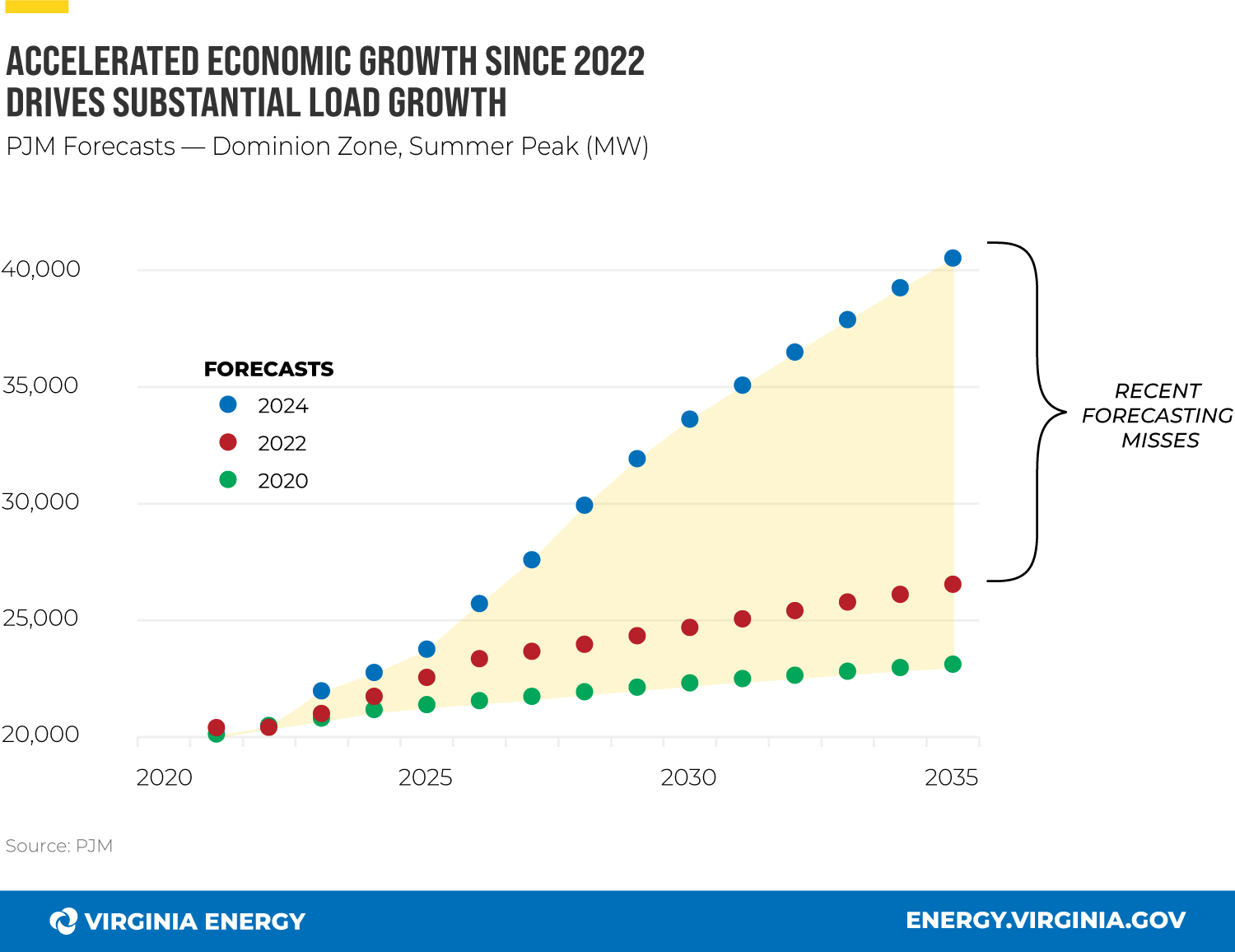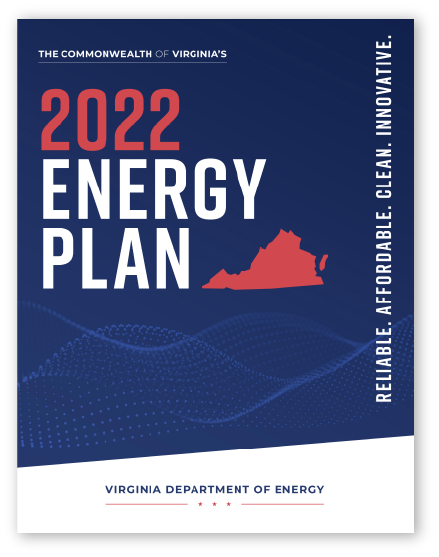Natural Gas In Virginia
Natural gas has been a vital component of Virginia's energy mix for nearly a century, providing reliable and affordable power to homes and businesses across the Commonwealth. In fact, natural gas accounts for just over 50% of Virginia's electric capacity, making it the largest single source of energy in the state.
Virginia Relies on Natural Gas for 55% of its Power
Looking forward, natural gas must continue to play a significant role in Virginia's energy landscape. Virginia is the epicenter of the nation’s recent AI and data center infrastructure boom and named the best state to do business in 2023 by CNBC. Our economic success has created jobs and put food on tables, but it has also created an unprecedented growth in energy demand. To meet this challenge and ensure that Virginia remains the best state to do business, natural gas’s unmatched reliability and affordability are needed to offset the costs and intermittent generation issues associated with renewable sources like wind and solar.
Enacted in 2020, the Virginia Clean Economy Act (VCEA) mandates the retirement of Virginia's entire natural gas fleet by 2045. However, complying with the VCEA as written would result in a significant energy production shortfall by 2035.
In light of this and recognizing the critical role of natural gas as a reliable dispatchable energy source, Governor Glenn Youngkin’s administration is exploring innovative solutions to gas’s environmental challenges.
Innovative technologies like renewable gas, advances in methane monitoring, and carbon capture, utilization, and storage (CCUS) are all available tools for further reducing the environmental impact of already clean burning natural gas. Some states have already begun making investments in these types of technologies, such as Texas, which is on track to deploy a near zero-emission natural gas plant by 2028.
Additional information on natural gas production in Virginia available here.
Natural Gas Benefits:
Affordability
Natural gas is a cost-effective energy source, providing significant savings for residential, commercial, and industrial consumers.
Reliability
Natural gas power plants can quickly ramp up or down to meet changing electricity demand, providing a reliable and flexible energy source to complement renewable energy. It can generate electricity 24/7, unlike intermittent renewable sources that are dependent on weather conditions.
Environmental Benefits
Compared to other fossil fuels, burning natural gas results in significantly lower emissions of greenhouse gases and other pollutants, making it one of the cleaner traditional energy options. Investment in advanced carbon capture, utilization, and storage (CCUS) technologies will make Natural Gas even cleaner!
Grid Resilience
Incorporating natural gas as part of an all-of-the-above energy mix helps ensure the stability and resilience of Virginia's energy grid by serving as a bridge fuel for times when intermittent sources like solar and wind are not generating power.
Economic Impact
The natural gas industry supports thousands of jobs in Virginia, from extraction and transportation to power generation and distribution. It also contributes significantly to the state's economy through investments and tax revenues.
Energy Security
The United States has abundant natural gas reserves, reducing reliance on imported energy, enhancing energy security, and mitigating the risks associated with global market volatility.
Natural Gas Challenges
Methane Emissions
In recent years, global economic uncertainty and geopolitical turmoil have put our reliance on foreign energy imports in the spotlight. The U.S. is investing heavily in solar projects at a time when China controls over 80% of global solar manufacturing capacity. This dependence on foreign manufacturing poses a significant risk to our nation's energy security.
Mitigating Methane Emissions
Virginia is working closely with the natural gas industry to implement best practices and technologies to detect, capture, and reduce methane emissions across the natural gas supply chain. Regulatory oversight and collaboration with environmental groups also play a key role in addressing this challenge.
Infrastructure Needs
The expansion of natural gas production and distribution infrastructure, such as pipelines and storage facilities, can face challenges related to environmental impact assessments, community concerns, and complex permitting processes.
Process Improvements
Virginia continues to support improvements to the permitting and approval processes for natural gas infrastructure project, as well as local community and environmental stakeholder engagement to address concerns and ensure responsible development.
Natural Gas Technology
Natural gas is a versatile and widely used energy source that plays a critical role in Virginia's energy landscape. It is used for electricity generation, heating, and as an industrial feedstock. Understanding the technologies involved in natural gas extraction, processing, and utilization is essential for appreciating its role in the energy sector.
Natural Gas 101
A range of technologies and processes are involved in the lifecycle of natural gas, from extraction to consumption. Below is an overview of some key technologies and methods used in the natural gas industry. For more information, visit the U.S. Energy Information Administration.
- Storage & Consumer Delivery: Natural gas delivery involves several infrastructure components, including processing, transportation, and storage. The gas must be processed to remove impurities before being transported through pipelines. This includes steps like dehydration and contaminant removal. Natural gas is transmitted via interstate and intrastate pipelines to consumer areas. Storage facilities, such as depleted fields and salt caverns are used to manage fluctuations in demand, ensuring supply during peak usage periods.
- Carbon Capture, Utilization, and Storage (CCUS): As concerns about greenhouse gas emissions grow, CCUS technology is being developed to capture carbon dioxide emissions from natural gas power plants and store them underground. This technology aims to reduce the environmental impact of emissions created by natural gas when used in power generation.
- Liquefied Natural Gas (LNG): Natural gas is cooled in order to convert it into a liquid form, which reduces its volume by about 600 times. This process facilitates the storage and transportation of natural gas over long distances, especially where pipelines are not feasible. LNG technology is crucial for exporting natural gas and for regions with limited pipeline infrastructure.
- Compressed Natural Gas (CNG): Natural gas is compressed to less than 1% of its volume at standard atmospheric pressure. CNG is used as a cleaner alternative to gasoline and diesel for vehicles, offering reduced emissions and cost savings.
- Combined Cycle Power Plants: These plants use both gas and steam turbines to generate electricity. Natural gas is burned in a gas turbine, and the hot exhaust gases are used to produce steam, which drives a steam turbine. This process increases the efficiency of electricity generation compared to traditional gas-fired power plants.
- Combustion Turbine: These plants use exhaust gases to drive a turbine to produce electricity. These facilities can spin up relatively fast to meet increasing demand.
- Hydraulic Fracturing (Fracking): This is a common method developed in the 1940’s used to extract natural gas from tight rock formations with low permeability. It involves injecting high-pressure fluid directly into the producing formations to fracture rock layers and release natural gas. Recent innovations in new fracking technologies, specifically around using recycled water, have helped to mitigate water usage. Typical hydraulic fracturing operations in Virginia do not use large quantities of water.
Additional Resources on Natural Gas
Department of Energy API provides users the same analytical tools available through the DOE’s web interface, without compromising the security or anonymity of the database.
Office of Fossil Energy and Carbon Management at the U.S. Department of Energy provides the latest research, data, and educational materials on natural gas and other fossil energy sources.
EIA Natural Gas Data and Analysis from the U.S. Energy Information Administration offers detailed statistics, reports, and analysis on the natural gas industry.
American Gas Association is the national trade association for the natural gas industry, offering resources, data, and policy updates.
National Energy Technology Laboratory
Interstate Natural Gas Association of America focuses on issues related to the natural gas pipeline network and infrastructure.
Natural Gas Supply Association provides information on natural gas supply, markets, and policy developments.


